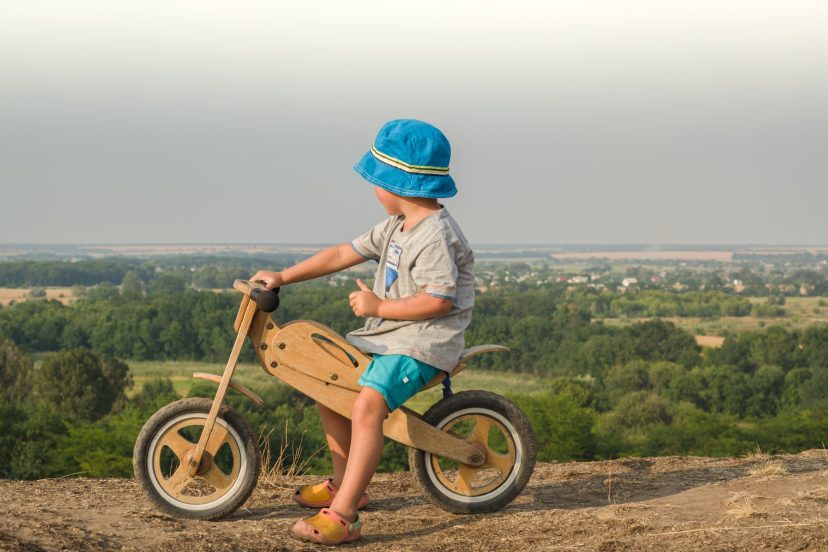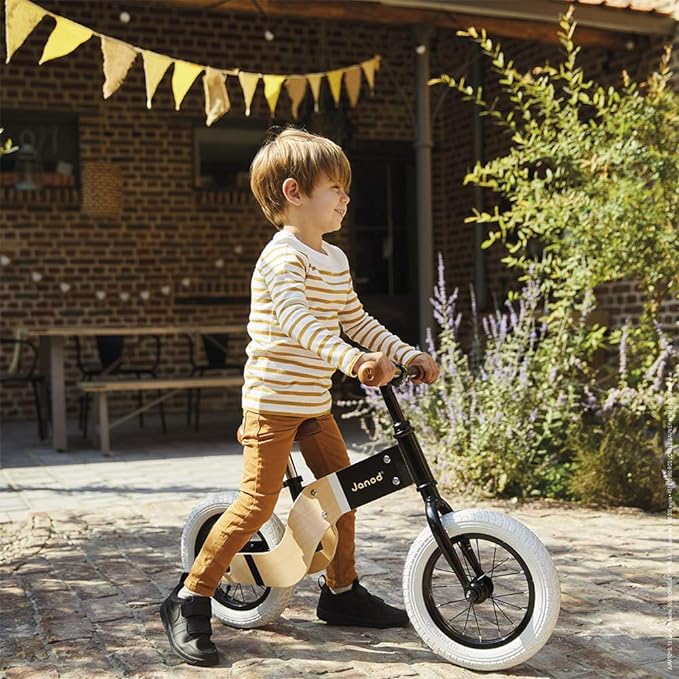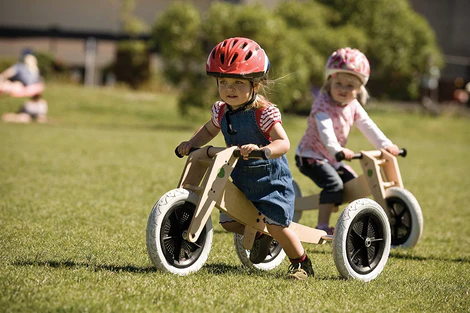Wooden Balance Bike: The Eco Choice for Young Riders
I strongly believe that wooden balance bikes are great for helping children grow physically and emotionally. They are excellent tools for outdoor play and development. These charming little bikes have been gaining popularity in recent years for all the right reasons. In this article, I will delve into the numerous advantages of using a wooden balance bike for your child’s playtime and development.
What is a Wooden Balance Bike?
Before we dive into the benefits of them, let’s clarify what exactly a wooden balance bike is. A wooden balance bike is a pedal-less bicycle designed to help children learn balance and coordination.
Unlike traditional bicycles, these bikes do not have pedals or training wheels, allowing children to focus solely on balancing and steering.
The Phyical Benefits of Using a Wooden Balance Bike
Balance and Coordination
One of the primary physical benefits of wooden balance bikes is their ability to enhance a child’s balance and coordination. When kids ride these bikes, they learn how to distribute their weight effectively to stay upright. They intuitively adjust their position to maintain balance, constantly challenging themselves as they ride.
The process of balancing on a balance bike mirrors the skills needed to ride a regular bicycle. By mastering balance at an early age, children build a solid foundation for transitioning to pedal bikes later on. This skill acquisition is not only practical but also boosts a child’s self esteem as they conquer this fundamental aspect of bike riding.
Muscle Strength
Riding a wooden balance bike requires children to use their leg muscles actively. As they push themselves along the ground with their feet, they engage and strengthen their leg muscles, including the quadriceps, hamstrings, and calf muscles. This physical activity is not only fun but also contributes to the development of healthy, strong legs.
Additionally, the act of lifting their feet off the ground to glide on the bike’s frame further promotes muscle strength and control. This exercise is excellent for building gross motor skills, as children gradually develop the ability to move their legs precisely and with greater strength.
Motor Skills
Wooden balance bikes offer a comprehensive workout for a child’s motor skills. These bikes require kids to use both gross and fine motor skills simultaneously. Gross motor skills involve the coordination of larger muscle groups to perform activities like climbing, walking, running, and jumping. Riding a wooden balance bike stimulates gross motor skills as children use their legs to push, steer, and balance.
Fine motor skills, on the other hand, involve the use of smaller muscles for tasks that require precision and control. As children grasp the handlebars, manipulate the bike’s direction, and occasionally brake, they are refining their fine motor skills. The development of these motor skills is vital for a child’s overall physical dexterity and coordination, which are essential for various activities beyond bike riding, such as sports, arts and crafts, and even basic tasks like tying shoe laces.
The Mental & Social Benefits of Using a Wooden Balance Bike
Mastery of a New Skill
One of the most significant contributors to confidence in children is the mastery of a new skill. Riding a wooden balance bike represents a significant achievement for a young child. As they learn to balance, steer, and glide on their own, they experience a sense of accomplishment that boosts their self esteem. This mastery is a visible and tangible result of their efforts, and it often occurs relatively quickly.
When a child learns to glide smoothly and keep their balance, they feel more confident and capable.
This 3 in one is the ultimate wooden balance bike. Your little one can learn to walk, ride and balance, all-in-one. Ideal for 12 months to 5 years. This bike is the original learn to ride system for babies and preschoolers.
Overcoming Fear
Many children initially fear the idea of riding a bicycle, particularly one with pedals and training wheels. The prospect of falling can be scary for kids. Wooden balance bikes, with their low center of gravity and pedal free design, provide a safe and gradual introduction to biking. As children gain confidence on these bikes, their fear of cycling diminishes.
Conquering this fear is a huge step in a child’s development. It teaches them that they can overcome challenges and navigate new situations. This newfound courage and resilience extend beyond bike riding and help them approach various life experiences with greater confidence.
Sense of Independence
Wooden balance bikes empower children with a sense of independence. Unlike traditional bikes where parents often need to hold the seat or provide support, children using balance bikes can explore their outdoor surroundings on their terms. They gain the freedom to go where they want, when they want, without relying on others.
This independence fosters a strong sense of self reliance and autonomy. Children start making decisions about where they want to ride, how fast they want to go, and when they want to stop. These small choices contribute to a growing sense of self confidence, as they learn to trust their judgment and abilities.
Positive Feedback and Encouragement
As children ride their wooden balance bikes, they often receive positive feedback and encouragement from parents and caregivers. This reinforcement not only reinforces their self esteem but also strengthens the parent child bond.
Parents and caregivers typically celebrate each milestone, such as the first unassisted glide or the successful navigation of a challenging terrain. This encouragement provides children with a sense of pride and accomplishment, further fueling their confidence.
Setting and Achieving Goals
Using a wooden balance bike introduces children to the concept of setting and achieving goals. They learn that with practice and persistence, they can improve their biking skills. Each time they reach a new level of proficiency, they experience the satisfaction of goal achievement.
This early exposure to goal setting and achievement sets a positive precedent for their future efforts. They learn that putting in effort and staying focused will bring success. This mindset helps them develop a growth mindset that can benefit them in the long run.
Confidence in Decision Making
Independence on a balance bike encourages children to make decisions and take responsibility for their actions. They learn to assess the terrain, choose the best path, and make adjustments as needed. These decision making skills are valuable for developing problem solving abilities and confidence in their judgment.
Self-Reliance and Problem-Solving
Riding a balance bike often involves small challenges, such as navigating obstacles, avoiding bumps, and managing turns. Children learn to problem solve on there own as they encounter these obstacles. They discover how to adjust their body position, steer effectively, and maintain balance to overcome these challenges.
This self reliance and problem solving ability translate into valuable life skills. Children become more resourceful and better able to face obstacles and find solutions in various aspects of their lives.
Encouragement of Curiosity
Independence and freedom on a balance bike nurture children’s curiosity. They can explore new places, observe nature, and interact with their surroundings without constant adult supervision. This curiosity fuels their desire to learn and discover, promoting cognitive development.
As they explore the world on their balance bikes, children may ask questions, seek answers, and engage in creative play. This active curiosity is instrumental in developing their cognitive, social, and emotional skills.
Closing Thoughts From Me
A wooden balance bike helps kids feel independent and free. This is important for their physical, mental, and emotional growth. Children learn to explore, make decisions, build confidence, and solve problems on their own. This helps them become self reliant and empowered in life. These bikes not only offer a fun mode of getting around but also contribute to a child’s overall growth and well being.
FAQs
At what age can a child start using a wooden balance bike? Children as young as 18 months old can begin using wooden balance bikes.
How do I choose the right wooden balance bike for my child? Consider your child’s age, height, and the bike’s seat height to choose the most suitable option.
Are wooden balance bikes safe for young children? Yes, wooden balance bikes are considered safer than traditional bikes with pedals due to their pedal free design.
Do wooden balance bikes require a lot of maintenance? No, wooden balance bikes are low maintenance. Regular cleaning and occasional bolt tightening are usually sufficient.
Can wooden balance bikes help children transition to regular bicycles? Yes, wooden balance bikes teach children the fundamental skill of balance, making the transition to regular bikes smoother.







